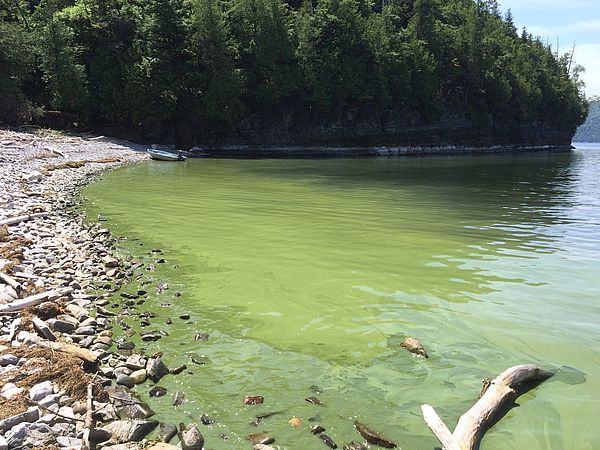LCC volunteer blue-green algae monitors have contributed nearly 1,000 reports of conditions around the lake so far this summer. Conditions to date have been better than normal with fewer, less intense blooms. The lower level of blooms is likely due to an absence of spring runoff. Not only was there a smaller than normal snowpack in the mountains, but spring rains were lacking too.
The Lake Champlain blue-green algae monitoring program has four components. First, the majority of observations come from LCC’s volunteer monitors that provide visual observations of water conditions at least once per week from sites around Lake Champlain. Second, a subset of volunteers and Vermont Department of Health (VDH) staff take weekly shoreline whole water samples for lab analysis. These samples allow direct comparison of the visual assessments and lab assessments and are targeted to areas either with frequent blooms or high public exposure. LCC has been responsible for recruiting and training monitors for Red Rocks Park (South Burlington), North Beach (Burlington), St. Albans Bay Park (St. Albans), and Shipyard (Highgate) for the water sampling portion of the program program. Third, the Vermont Department of Environmental Conservation (VT DEC) takes mid-lake samples every two weeks from each of 13 lake segments. These samples provide species identification and toxin testing (when densities are high). VT DEC sampling goes back to the mid-1990s providing a long-term record of changes in plankton composition. Finally, public water suppliers on the Vermont side of Lake Champlain provide weekly, whole water samples to VDH for toxin analysis. This is the second year of water supply testing. No finished water has had toxin detections since the testing program began.
VDH maintains an on-line tracker map that shows the most recent observations from LCC and other monitors. As reports come in from volunteers they are vetted for accuracy and added to the map multiple times per day. The map helps VDH meet a new statutory requirement that VDH provide outreach in the event that blooms present a public health hazard. The mere presence of a bloom does not indicate there is a public health hazard, but to be cautious all blooms reported are listed on the tracker. So far this year, no toxins have been detected in any of the samples tested. <link lcc-at-work algae-in-lake>Check out LCC's website for further information on how to detect, assess and keep safe from blooms and actions you can take to prevent their frequency.
